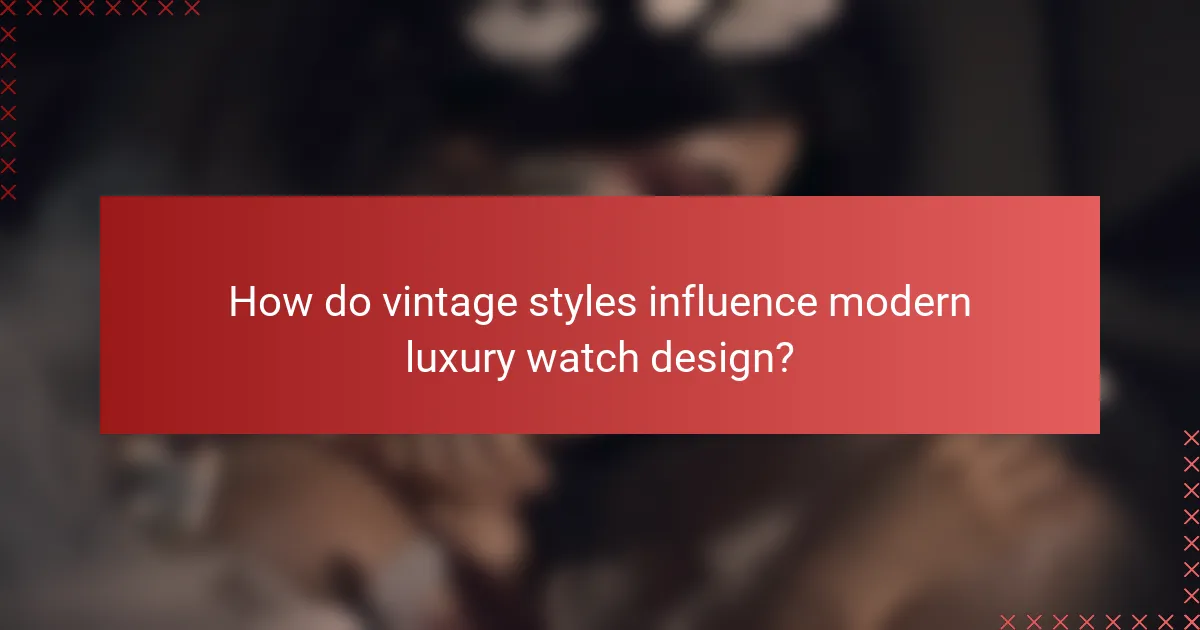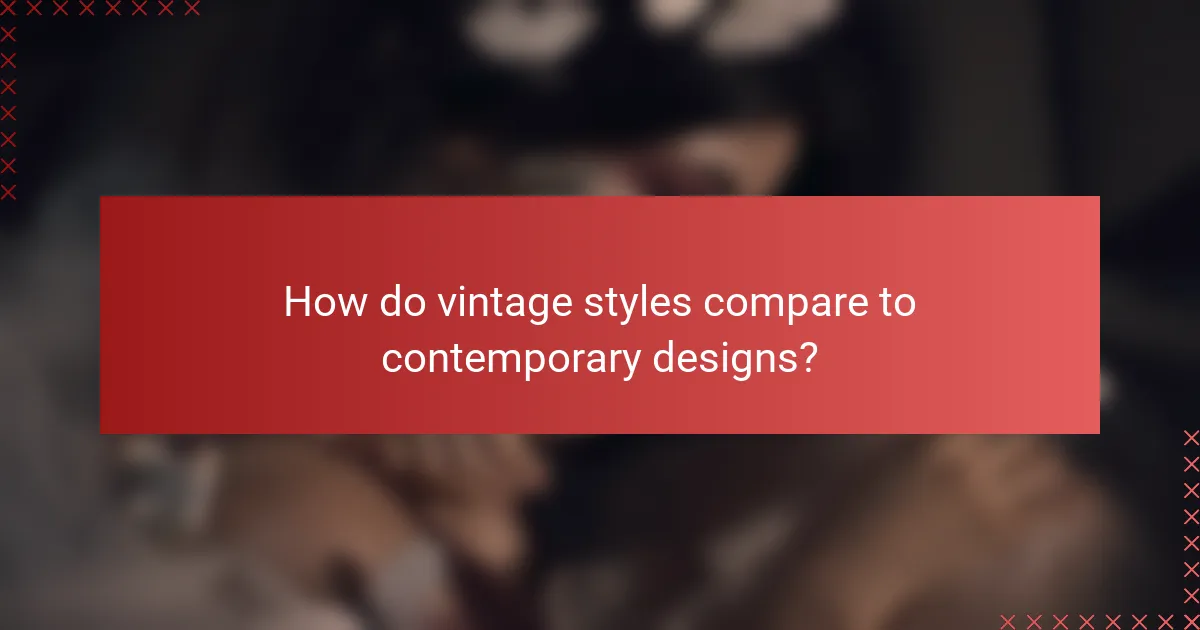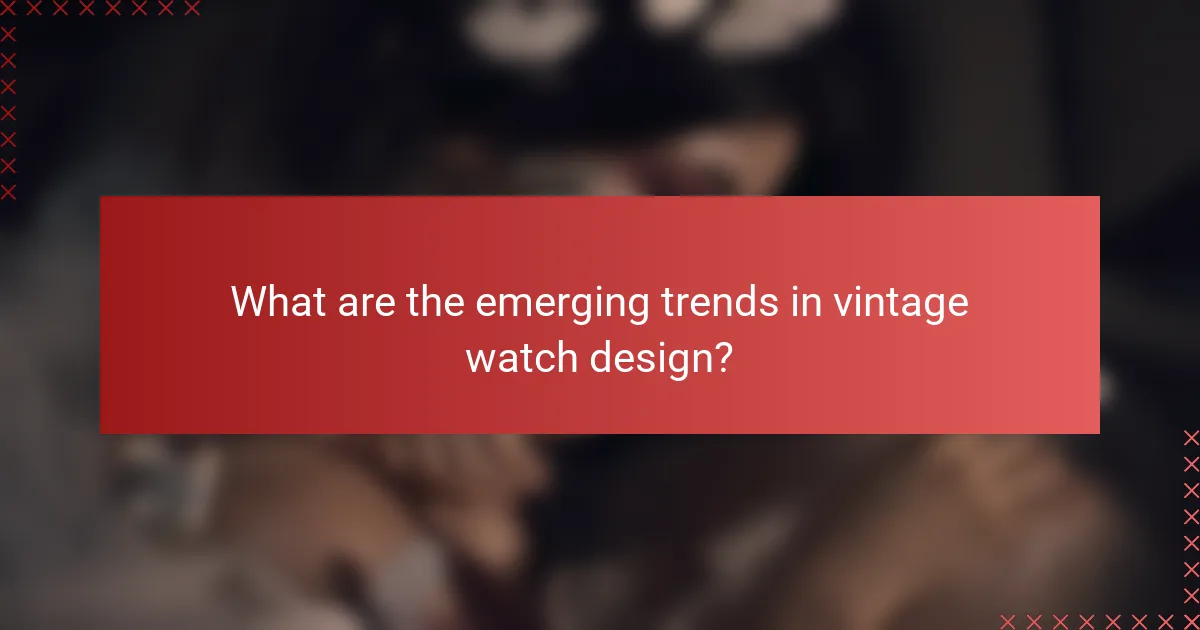Vintage styles play a pivotal role in shaping modern luxury watch design, seamlessly blending classic aesthetics with contemporary technology. By reviving iconic shapes and craftsmanship techniques, these timepieces evoke nostalgia while catering to the tastes of today’s collectors and enthusiasts. The result is a harmonious fusion of timeless design elements and high-quality materials that enhance both the appeal and functionality of luxury watches.

How do vintage styles influence modern luxury watch design?
Vintage styles significantly shape modern luxury watch design by incorporating classic aesthetics, materials, and functionalities that resonate with collectors and enthusiasts. This influence manifests in the revival of iconic shapes, dials, and craftsmanship techniques that evoke nostalgia while appealing to contemporary tastes.
Design elements from the 1920s to 1970s
Design elements from the 1920s to 1970s, such as Art Deco motifs, streamlined cases, and bold numerals, are prevalent in today’s luxury watches. Brands often draw inspiration from these eras to create timepieces that reflect a sense of history and sophistication. For instance, the use of vintage-inspired chronographs and patinaed dials adds character and depth to modern designs.
Additionally, materials like stainless steel and gold, which were popular in earlier decades, continue to dominate the luxury market. The revival of leather straps and intricate engravings also pays homage to the craftsmanship of the past, enhancing the appeal of contemporary watches.
Iconic brands embracing vintage aesthetics
Several iconic brands have successfully embraced vintage aesthetics, integrating them into their modern collections. For example, Rolex frequently reinterprets classic models such as the Submariner and Daytona, maintaining their timeless appeal while incorporating modern technology. These designs often feature vintage color palettes and case shapes that resonate with collectors.
Other brands like Omega and TAG Heuer have launched special editions that celebrate their heritage, often featuring retro logos and design cues from their historical models. This strategy not only attracts loyal customers but also appeals to a new generation seeking authenticity and style in luxury watches.

What are the key features of vintage-inspired luxury watches?
Vintage-inspired luxury watches often blend classic aesthetics with modern technology, emphasizing timeless design elements and craftsmanship. Key features include traditional dial designs, high-quality materials, and the use of age-old watchmaking techniques that enhance both appeal and functionality.
Classic dial designs and materials
Classic dial designs are characterized by simplicity and elegance, often featuring clean lines, Roman or Arabic numerals, and minimalistic hour markers. Materials such as enamel, brass, and stainless steel are commonly used, providing durability while maintaining a vintage look.
Many vintage-inspired watches incorporate patina effects or aged finishes to evoke a sense of history. These design choices not only enhance the visual appeal but also create a unique character that resonates with collectors and enthusiasts alike.
Use of traditional watchmaking techniques
Traditional watchmaking techniques, such as hand-winding movements and meticulous finishing, play a crucial role in vintage-inspired luxury watches. These methods ensure precision and reliability, often resulting in timepieces that can last for generations.
Brands may also employ techniques like guilloché engraving or enamel painting, which require skilled craftsmanship and add a distinctive touch to each watch. Understanding these techniques can help buyers appreciate the artistry and value behind their timepiece.

Which modern luxury watch brands incorporate vintage styles?
Many modern luxury watch brands draw inspiration from vintage styles, blending classic aesthetics with contemporary technology. Notable brands like Rolex and Omega have successfully integrated heritage designs into their current collections, appealing to both collectors and new enthusiasts.
Rolex and its heritage models
Rolex is renowned for its heritage models that reflect timeless designs and robust functionality. The Submariner and Daytona are prime examples, showcasing vintage elements such as the classic dial layout and iconic case shapes that have remained largely unchanged over decades.
When considering a Rolex with vintage appeal, look for models with specific features like acrylic crystals or patina on the dials, which can enhance their character and value. Collectors often seek out these vintage characteristics, as they add uniqueness to each piece.
Omega’s Seamaster vintage editions
Omega’s Seamaster line includes several vintage editions that resonate with watch enthusiasts. The Seamaster 300 and the Seamaster 200 are celebrated for their historical significance and design elements that hark back to the mid-20th century, such as the distinctive bezel and vintage logo.
For those interested in acquiring a Seamaster with vintage charm, consider models with original features like the “Big Triangle” hour markers or the classic wave-patterned dials. These details not only enhance the watch’s aesthetic but also contribute to its investment potential in the luxury market.

How does vintage style affect consumer appeal?
Vintage style significantly enhances consumer appeal by evoking nostalgia and a sense of timelessness. Many buyers are drawn to the craftsmanship and unique aesthetics of vintage designs, which often stand out against contemporary trends.
Emotional connection to history
Vintage styles create a powerful emotional connection to history, allowing consumers to feel part of a legacy. This connection often stems from the stories behind the designs, such as iconic models that have stood the test of time or were worn by influential figures.
For instance, a watch inspired by a classic military model may resonate with consumers who value heritage and adventure. This emotional bond can lead to a stronger attachment to the product, making it more desirable.
Perceived value and exclusivity
The perceived value of vintage-inspired watches often exceeds that of modern designs due to their uniqueness and limited availability. Consumers tend to associate vintage styles with higher quality and craftsmanship, which can justify a premium price.
Exclusivity plays a crucial role; limited editions or designs that pay homage to rare vintage pieces can create a sense of urgency among buyers. This can lead to increased demand and higher resale values, making such watches not just accessories but also investment pieces.

What are the pricing trends for vintage-inspired luxury watches?
Pricing trends for vintage-inspired luxury watches have shown a steady increase, reflecting a growing appreciation for classic designs and craftsmanship. Collectors and enthusiasts are willing to pay a premium for pieces that evoke nostalgia while incorporating modern technology.
Market analysis of vintage watch auctions
The market for vintage watch auctions has become increasingly competitive, with many pieces fetching prices that exceed initial estimates. Notable auction houses often report that iconic models from renowned brands can sell for tens of thousands to even millions of dollars, depending on rarity and condition.
Recent trends indicate that watches from the 1960s and 1970s are particularly sought after, as they combine historical significance with appealing aesthetics. Buyers should monitor auction results to gauge demand and pricing fluctuations in this segment.
Impact of brand reputation on pricing
Brand reputation plays a crucial role in determining the pricing of vintage-inspired luxury watches. Established brands like Rolex, Patek Philippe, and Omega often command higher prices due to their legacy and perceived value among collectors.
When considering a purchase, it’s essential to evaluate how a brand’s history, craftsmanship, and market presence influence its watches’ resale value. Lesser-known brands may offer attractive designs at lower prices but may not retain value as effectively as their more prestigious counterparts.

What are the criteria for selecting a vintage-inspired luxury watch?
Selecting a vintage-inspired luxury watch involves evaluating its authenticity, condition, and restoration history. These criteria ensure that the watch not only reflects the desired aesthetic but also maintains value and integrity over time.
Authenticity and provenance
Authenticity is crucial when choosing a vintage-inspired luxury watch. Look for documentation that verifies the watch’s origin, such as original papers, receipts, or certificates of authenticity. Provenance, or the watch’s ownership history, can significantly enhance its value, especially if it has been owned by notable individuals or has a unique backstory.
When assessing authenticity, consider the brand’s specific features, such as logos, engravings, and serial numbers. Researching these details can help you avoid replicas or counterfeit models that may appear similar at first glance.
Condition and restoration history
The condition of a vintage-inspired luxury watch is a key factor in its desirability and value. Examine the watch for signs of wear, such as scratches on the crystal, fading on the dial, or damage to the case. A well-preserved watch will generally command a higher price than one in poor condition.
Restoration history is equally important. A watch that has undergone professional restoration can be a good investment, provided it was done by a reputable service. However, excessive or improper restoration can detract from the watch’s value. Always inquire about the extent of any repairs and whether original parts were used.

How do vintage styles compare to contemporary designs?
Vintage styles in luxury watch design often emphasize traditional craftsmanship and timeless aesthetics, while contemporary designs focus on modern technology and innovative materials. The appeal of vintage watches lies in their unique character and history, contrasting with the sleek, often minimalist look of today’s timepieces.
Differences in craftsmanship and technology
Vintage watches are typically crafted using traditional techniques that prioritize hand-finished details and mechanical movements. This craftsmanship can result in a distinct charm and individuality, as each piece reflects the artisan’s skill.
In contrast, contemporary designs leverage advanced technology, such as quartz movements and high-tech materials like ceramics and titanium. These innovations often enhance durability and precision, appealing to consumers seeking reliability and functionality in their timepieces.
Consumer preferences for aesthetics
Many consumers are drawn to the nostalgic appeal of vintage styles, which often feature intricate dials, classic fonts, and unique case shapes. This aesthetic resonates with those who appreciate the heritage and story behind each watch.
On the other hand, modern luxury watches tend to favor minimalist designs with clean lines and understated elegance. This shift reflects a broader trend towards simplicity and versatility, catering to consumers who prefer a more contemporary look that can easily transition from casual to formal settings.

What are the emerging trends in vintage watch design?
Emerging trends in vintage watch design focus on blending classic aesthetics with modern functionality. This includes the integration of smart technology and the revival of retro styles in new collections, appealing to both traditional watch enthusiasts and tech-savvy consumers.
Integration of smart technology
The integration of smart technology into vintage watch designs allows brands to maintain traditional aesthetics while offering modern features. Smart functionalities can include fitness tracking, notifications, and even customizable watch faces, catering to the needs of contemporary users.
Brands like TAG Heuer and Fossil have successfully launched smartwatches that mimic the look of classic timepieces. This trend enables consumers to enjoy the charm of vintage styles without sacrificing the convenience of modern technology.
Revival of retro styles in new collections
The revival of retro styles in new collections is a significant trend in the luxury watch market. Many brands are reissuing iconic designs from past decades, often with updated materials and movements that enhance durability and performance.
For instance, Seiko and Omega have released limited editions that pay homage to their historical models, attracting collectors and new buyers alike. This trend not only celebrates the heritage of watchmaking but also appeals to consumers looking for unique pieces that stand out in a modern context.
